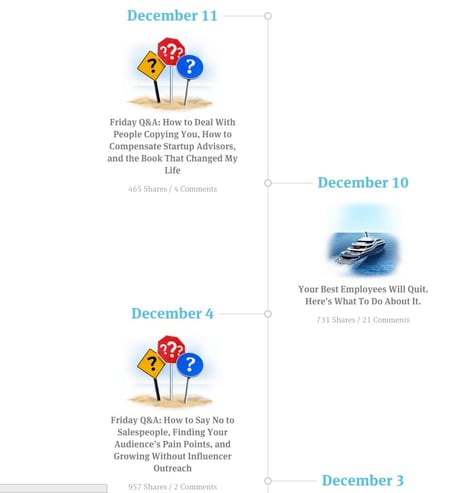-
Best Ways to Master Brand Positioning With Content Marketing
-
5 Brand Positioning Principles to Guide Your Content Marketing Efforts
-
1. Forget about product features. Align your content with your prospects' lifestyle instead.
-
2. Create content that makes your brand desirably different from the competition.
-
3. Solve a major pain point and be ridiculously good at it!
-
4. Seek customer feedback and position your content based on the results.
-
5. Insane honesty is your ally.

5 Best Ways to Position Your Brand Through Content Marketing
One of the biggest questions that marketing teams often get asked about by clients is:
How do I make content marketing work?
With this concern, it's quite clear that brands understand the theory behind content marketing but are failing miserably with practical methods in leveraging content to hit marketing goals.
Best Ways to Master Brand Positioning With Content Marketing
Many marketers have moved on from the timeworn advice of creating content and waiting for one of those content pieces to strike gold. The clamor for answers has now shifted to the hows of content marketing, not the whys.
You want the behind-the-scenes. The meat and bones. The nitty gritty.
And this is where a disconnect becomes glaringly obvious.
It turns out that there's a huge gap between producing content and a neat blueprint behind it. The 2015 content marketing stats reveal that strategy is one area of content marketing that B2B marketers would want to learn more about. With too much competition, this gap could potentially explain why no one is reading your content.
Enter brand positioning.
Next to superb storytelling, positioning is one field of content marketing strategy to which brands should pay attention.
It is defined as:
The art of sharing your company's unique value in ways that resonate with your buyer, compelling them to engage, trust, and -- ultimately -- buy from you.
5 Brand Positioning Principles to Guide Your Content Marketing Efforts
Find out if your brand is already implementing one or more of the following brand positioning principles below. You're more than welcome to add them to your branding bag of tricks if they're not in your blueprint yet!
1. Forget about product features. Align your content with your prospects' lifestyle instead.
With a few exceptions, no one gives a hoot about how technologically superior your newest lines of products are.
No one will be relieved to know if you write about how your dental office is located in the heart of the city. But if you change the content (perhaps an infographic) to focus on how your patients can easily get in touch with you via email, phone, or a personal consultation through a 3-minute walk from the central bus station, your prospects' perception of your accessibility will shift.
Take it from Steve Jobs: Instead of pitching the iPod's storage capacity (1GB of storage), he cleverly positioned the iPod with the 1,000 songs in your pocket concept.

As entrepreneur Marc Barros pointed out:
It's not about the performance of the product, it's about the lifestyle of the person using the product.
2. Create content that makes your brand desirably different from the competition.
What if the niche you're in is overly saturated? What if you have the same product features or services as the competition?
In her book The Startup Guide to Differentiation, copywriter, and messaging strategist Joanna Wiebe discussed how startups can stand out and eventually get noticed through the following categories:
- target market, audience, or niche
- customer focus
- design
- features or components
- innovation
- people behind your brand
- production or creation
- price
- worldview
As a brand strategist or marketer, you can also use the key differentiators above in your content marketing efforts.
Let's use the first category as an example. So you're a plastic surgeon in San Francisco. With too many plastic surgeons in the area, potential patients have a lot of choices. This leaves you with a lackluster client list.
However, if you start setting yourself apart as an expert in a particular niche, you'll most likely gain traction right away. Why not start with eBooks, blog posts, and videos focusing on breast reconstruction through implants after breast cancer removal?
Instead of trying to gain everyone's attention, build a community of women who just underwent surgery to treat breast cancer and focus your plastic surgery skills in helping this niche instead. Once you've built a reputation in this niche, word-of-mouth referrals will certainly do wonders!
3. Solve a major pain point and be ridiculously good at it!
Before help desk software Groove had a stellar blog reputation, they admitted that blogging used to be a serious struggle. So how did they grew their blog to approximately 5000 subscribers in 5 weeks.

In a blog post reflecting their most popular pieces, founder Alex Turnbull wrote that solving a deep burning pain of their target audiences was a common thread among their most shared and controversial posts.
How can you figure out those deep, burning pain points of your prospects?
Torture chambers aside, this brings us to the next on the list -- positioning your brand through constant customer feedback.
4. Seek customer feedback and position your content based on the results.
Came up with their audience personas through research and surveys.
Say you're a SaaS team developing payroll software. In a brainstorming session with your team on potential customers, CEOs and HR managers were on top of your list. However, following a survey as suggested by one of the team members, it turns out that a huge chunk of your website visitors (and lurkers!) are restaurant owners looking for a way to better manage their restaurant's payroll system. Who would have thought?
With those new insights, the SaaS team can come up with an audience-focused content marketing campaign for restaurant owners.
5. Insane honesty is your ally.
Groove and Buffer are brands that are popular for their open and honest approach to their blog content. They willingly share their revenues and write about their struggles too. Given their recent revenues and large following, it looks like transparency lives up to its reputation.

Velocity's Doug Kessler refers to it as insane honesty. Being totally transparent makes your brand positioning more believable, and consequently builds trust.
Groove's Alex Turnbull is quick to point out though that transparency is more than just sharing numbers. It should be founded on sharing what you've learned to deliver value. Do not opt for the transparency route if your intention is to simply draw in more subscribers.
Now that you have tons of ideas to stay top of mind with brand positioning through content learn how you can measure the impact of your content marketing efforts.
Did we miss other brand positioning hacks that are specific to content marketing? We'd love to hear your thoughts in the comments!





